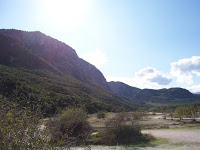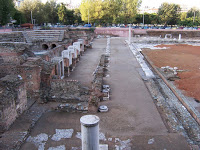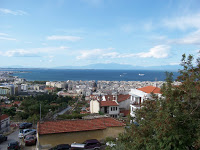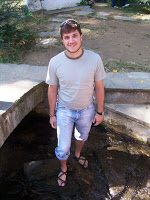Olympia was definitely my favorite place on the Southern Greece trip. It was extremely beautiful, there were trees that were actually changing colors, and it was really the first time all semester that it actually felt like fall. I loved it there.
We started by going to a really cool museum where we got to see lots of amazing statues (Like Hermes, and Nike) and some really cool artifacts, like weapons and armor dedicated to Zeus. Speaking of Zeus, he was the patron god of Olympia (even though it is no where close to Mt. Olympus). The Olympic games, which were held every 4 years, were dedicated to Zeus. The Temple of Zeus, which is now mostly in ruins thanks to earthquakes, used to house the great statue of Zeus, one of the 7 wonders of the ancient world. Unfortunately, like all but one ancient wonder the Statue of Zeus is now destroyed. We got to see a really nice artist’s rendition of it, though…
The site of ancient Olympia was one of the prettiest places I have been in Greece. It was just a perfect day to tour the site. We saw a couple gymnasiums, the Temple of Zeus, an old basilica dating to the 4th Cent. AD, and the Temple of Hera (Zeus’ wife) where they light the Olympic Torch every 4 years.
At the end of our tour we came to the famous Olympic Stadium…more like dirt track/field. This was not the first Olympic track, technically. This one was built in order to accommodate larger crowds and more participants, but it’s close enough. We were able to race on the track, which was a lot of fun. We ran it like they would have back 2500 years ago…no, not naked…down and back one time – winner takes all. It’s 192 meters one way, and four of us, including myself, ran it in 60 seconds or less. I loved it.
____________
Well that pretty much wraps up the Peloponnese trip. Highlights: Acrocorinth, Citadel of Mycenae, Theater of Epidaurus, and the Olympic Track
Next on the agenda is a recap of our trip to Israel. I can’t wait to share my experiences with you.








